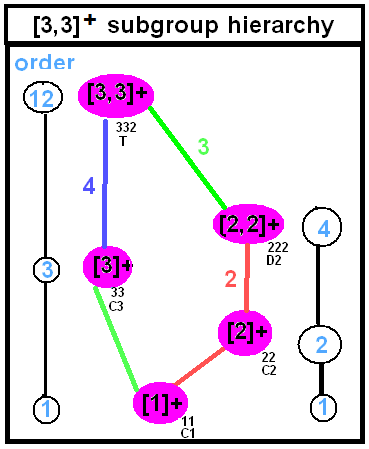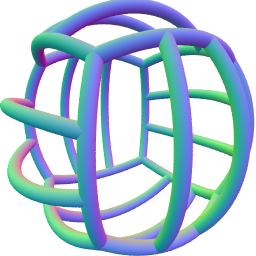Tetrahedral symmetry on:
[Wikipedia]
[Google]
[Amazon]
150px, A regular tetrahedron, an example of a solid with full tetrahedral symmetry
A regular


 Th, 3*2, ,3+or m, of order 24 – pyritohedral symmetry. This group has the same rotation axes as T, with mirror planes through two of the orthogonal directions. The 3-fold axes are now S6 () axes, and there is a central inversion symmetry. Th is isomorphic to : every element of Th is either an element of T, or one combined with inversion. Apart from these two normal subgroups, there is also a normal subgroup D2h (that of a
Th, 3*2, ,3+or m, of order 24 – pyritohedral symmetry. This group has the same rotation axes as T, with mirror planes through two of the orthogonal directions. The 3-fold axes are now S6 () axes, and there is a central inversion symmetry. Th is isomorphic to : every element of Th is either an element of T, or one combined with inversion. Apart from these two normal subgroups, there is also a normal subgroup D2h (that of a

* Norman Johnson (mathematician), N.W. Johnson: ''Geometries and Transformations'', (2018) Chapter 11: ''Finite symmetry groups'', 11.5 Spherical Coxeter groups
tetrahedron
In geometry, a tetrahedron (plural: tetrahedra or tetrahedrons), also known as a triangular pyramid, is a polyhedron composed of four triangular faces, six straight edges, and four vertex corners. The tetrahedron is the simplest of all ...
has 12 rotational (or orientation-preserving
The orientation of a real vector space or simply orientation of a vector space is the arbitrary choice of which ordered bases are "positively" oriented and which are "negatively" oriented. In the three-dimensional Euclidean space, right-handed ...
) symmetries, and a symmetry order of 24 including transformations that combine a reflection and a rotation.
The group of all (not necessarily orientation preserving) symmetries is isomorphic to the group S4, the symmetric group
In abstract algebra, the symmetric group defined over any set is the group whose elements are all the bijections from the set to itself, and whose group operation is the composition of functions. In particular, the finite symmetric group ...
of permutations of four objects, since there is exactly one such symmetry for each permutation of the vertices of the tetrahedron. The set of orientation-preserving symmetries forms a group referred to as the alternating subgroup A4 of S4.
Details
Chiral and full (or achiral tetrahedral symmetry and pyritohedral symmetry) are discrete point symmetries (or equivalently, symmetries on the sphere). They are among thecrystallographic point groups
In crystallography, a crystallographic point group is a set of symmetry operations, corresponding to one of the point groups in three dimensions, such that each operation (perhaps followed by a translation) would leave the structure of a crystal un ...
of the cubic crystal system
In crystallography, the cubic (or isometric) crystal system is a crystal system where the unit cell is in the shape of a cube. This is one of the most common and simplest shapes found in crystals and minerals.
There are three main varieties ...
.
Seen in stereographic projection
In mathematics, a stereographic projection is a perspective projection of the sphere, through a specific point on the sphere (the ''pole'' or ''center of projection''), onto a plane (the ''projection plane'') perpendicular to the diameter thro ...
the edges of the tetrakis hexahedron form 6 circles (or centrally radial lines) in the plane. Each of these 6 circles represent a mirror line in tetrahedral symmetry. The intersection of these circles meet at order 2 and 3 gyration points.
Chiral tetrahedral symmetry
''T'', 332, ,3sup>+, or 23, of order 12 – chiral or rotational tetrahedral symmetry. There are three orthogonal 2-fold rotation axes, like chiral dihedral symmetry ''D''2 or 222, with in addition four 3-fold axes, centered ''between'' the three orthogonal directions. This group isisomorphic
In mathematics, an isomorphism is a structure-preserving mapping between two structures of the same type that can be reversed by an inverse mapping. Two mathematical structures are isomorphic if an isomorphism exists between them. The word i ...
to ''A''4, the alternating group
In mathematics, an alternating group is the group of even permutations of a finite set. The alternating group on a set of elements is called the alternating group of degree , or the alternating group on letters and denoted by or
Basic pr ...
on 4 elements; in fact it is the group of even permutation
In mathematics, when ''X'' is a finite set with at least two elements, the permutations of ''X'' (i.e. the bijective functions from ''X'' to ''X'') fall into two classes of equal size: the even permutations and the odd permutations. If any total o ...
s of the four 3-fold axes: e, (123), (132), (124), (142), (134), (143), (234), (243), (12)(34), (13)(24), (14)(23).
The conjugacy classes of T are:
*identity
*4 × rotation by 120° clockwise (seen from a vertex): (234), (143), (412), (321)
*4 × rotation by 120° counterclockwise (ditto)
*3 × rotation by 180°
The rotations by 180°, together with the identity, form a normal subgroup
In abstract algebra, a normal subgroup (also known as an invariant subgroup or self-conjugate subgroup) is a subgroup that is invariant under conjugation by members of the group of which it is a part. In other words, a subgroup N of the group G ...
of type Dih2, with quotient group
A quotient group or factor group is a mathematical group obtained by aggregating similar elements of a larger group using an equivalence relation that preserves some of the group structure (the rest of the structure is "factored" out). For exam ...
of type Z3. The three elements of the latter are the identity, "clockwise rotation", and "anti-clockwise rotation", corresponding to permutations of the three orthogonal 2-fold axes, preserving orientation.
A4 is the smallest group demonstrating that the converse of Lagrange's theorem is not true in general: given a finite group ''G'' and a divisor ''d'' of , ''G'', , there does not necessarily exist a subgroup of ''G'' with order ''d'': the group has no subgroup of order 6. Although it is a property for the abstract group in general, it is clear from the isometry group of chiral tetrahedral symmetry: because of the chirality the subgroup would have to be C6 or D3, but neither applies.
Subgroups of chiral tetrahedral symmetry

Achiral tetrahedral symmetry
Td, *332, ,3or 3m, of order 24 – achiral or full tetrahedral symmetry, also known as the (2,3,3) triangle group. This group has the same rotation axes as T, but with six mirror planes, each through two 3-fold axes. The 2-fold axes are now S4 () axes. Td and O are isomorphic as abstract groups: they both correspond to S4, thesymmetric group
In abstract algebra, the symmetric group defined over any set is the group whose elements are all the bijections from the set to itself, and whose group operation is the composition of functions. In particular, the finite symmetric group ...
on 4 objects. Td is the union of T and the set obtained by combining each element of with inversion. See also the isometries of the regular tetrahedron.
The conjugacy classes of Td are:
*identity
*8 × rotation by 120° (C3)
*3 × rotation by 180° (C2)
*6 × reflection in a plane through two rotation axes (Cs)
*6 × rotoreflection by 90° (S4)
Subgroups of achiral tetrahedral symmetry

Pyritohedral symmetry
 Th, 3*2, ,3+or m, of order 24 – pyritohedral symmetry. This group has the same rotation axes as T, with mirror planes through two of the orthogonal directions. The 3-fold axes are now S6 () axes, and there is a central inversion symmetry. Th is isomorphic to : every element of Th is either an element of T, or one combined with inversion. Apart from these two normal subgroups, there is also a normal subgroup D2h (that of a
Th, 3*2, ,3+or m, of order 24 – pyritohedral symmetry. This group has the same rotation axes as T, with mirror planes through two of the orthogonal directions. The 3-fold axes are now S6 () axes, and there is a central inversion symmetry. Th is isomorphic to : every element of Th is either an element of T, or one combined with inversion. Apart from these two normal subgroups, there is also a normal subgroup D2h (that of a cuboid
In geometry, a cuboid is a hexahedron, a six-faced solid. Its faces are quadrilaterals. Cuboid means "like a cube", in the sense that by adjusting the length of the edges or the angles between edges and faces a cuboid can be transformed into a c ...
), of type . It is the direct product of the normal subgroup of T (see above) with C''i''. The quotient group
A quotient group or factor group is a mathematical group obtained by aggregating similar elements of a larger group using an equivalence relation that preserves some of the group structure (the rest of the structure is "factored" out). For exam ...
is the same as above: of type Z3. The three elements of the latter are the identity, "clockwise rotation", and "anti-clockwise rotation", corresponding to permutations of the three orthogonal 2-fold axes, preserving orientation.
It is the symmetry of a cube with on each face a line segment dividing the face into two equal rectangles, such that the line segments of adjacent faces do not meet at the edge. The symmetries correspond to the even permutations of the body diagonals and the same combined with inversion. It is also the symmetry of a pyritohedron, which is extremely similar to the cube described, with each rectangle replaced by a pentagon with one symmetry axis and 4 equal sides and 1 different side (the one corresponding to the line segment dividing the cube's face); i.e., the cube's faces bulge out at the dividing line and become narrower there. It is a subgroup of the full icosahedral symmetry group (as isometry group, not just as abstract group), with 4 of the 10 3-fold axes.
The conjugacy classes of Th include those of T, with the two classes of 4 combined, and each with inversion:
*identity
*8 × rotation by 120° (C3)
*3 × rotation by 180° (C2)
*inversion (S2)
*8 × rotoreflection by 60° (S6)
*3 × reflection in a plane (Cs)
Subgroups of pyritohedral symmetry

Solids with chiral tetrahedral symmetry
The Icosahedron colored as a snub tetrahedron has chiral symmetry.Solids with full tetrahedral symmetry
See also
* Octahedral symmetry * Icosahedral symmetry * Binary tetrahedral group *References
* Peter R. Cromwell, ''Polyhedra'' (1997), p. 295 * ''The Symmetries of Things'' 2008, John H. Conway, Heidi Burgiel, Chaim Goodman-Strass, * ''Kaleidoscopes: Selected Writings of H.S.M. Coxeter'', edited by F. Arthur Sherk, Peter McMullen, Anthony C. Thompson, Asia Ivic Weiss, Wiley-Interscience Publication, 1995,* Norman Johnson (mathematician), N.W. Johnson: ''Geometries and Transformations'', (2018) Chapter 11: ''Finite symmetry groups'', 11.5 Spherical Coxeter groups
External links
* {{DEFAULTSORT:Tetrahedral Symmetry Finite groups Rotational symmetry